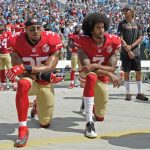The San Franciso 49ers quarterback Colin Kaepernick started it during the preseason by kneeling during the national anthem. He has since been joined by players on other teams.
As the national Football League regular season enters its third week, the number of players choosing to make a protest statement during the national anthem by either kneeling or raising a fist in the air has increased, though it seems to have leveled off. Some players were protesting specific incidents, such as the police shooting of Keith Scott in Charlotte, North Carolina, last week, while others see their actions as supporting broader initiatives such as the Black Lives Matter movement or deeper societal injustices and racial inequalities.
What all of the player protests lack, however, is a communications campaign exit strategy.
It is unlikely that the United States’ longstanding issues of racial inequality and police brutality will be solved during the 2016 NFL season, so once players have raised a fist or taken a knee, they are obligated to continue to do so for 16 or more games or explain why they have suspended their protest. And while their actions continue to generate comments early in the season, it’s unlikely that they will continue to be noted, say, eight games in.
Forty years ago when Tommie Smith and John Carlos raised black-gloved fists during the medal ceremony for the 200-meter sprint at the 1968 Summer Olympics, it was a one-shot deal. The impact of the gesture has followed both men through the subsequent four decades, and the contemporary response was swift — the U.S. Olympic Committee suspended both athletes and banished them from the games. Both men returned to the U.S. to nearly universal disapproval and anonymous death threats, and both have struggled to achieve success in the intervening years.
In contrast, today’s protesting athletes have provoked relatively mild criticism for their actions and have had a correspondingly minimal impact on the issues they are attempting to highlight. Perhaps it’s the idea that these privileged football players — many of whom received a college education on scholarship and now receive handsome salaries for playing a game, after all — are risking little to stage their protest, and consequently, their protests really do little to further their causes.
Indeed, a recent Yahoo poll found that 47 percent of Americans opposed Kaepernick’s and his colleagues’ protests, while only 32 percent support them. And according to Forbes magazine, TV viewership was down for the 2016 season opener and also for “Sunday Night Football,” a perennial sports blockbuster.
From a communications standpoint, the players’ campaign was doomed from the start. Unless cops stop shooting unarmed black men or race relations improve dramatically or there is a sudden redistribution of wealth in this country within the next three or four months, they cannot suspend their protests without looking foolish, but if they continue, in time their acts are bound to become at best meaningless, at worst, harmful to their causes.
So for the balance of the regular season and possibly into the playoffs, we will watch as professional athletes raise a fist or take a knee during the national anthem until we become inured to the sight and forget why they started doing it in the first place.
